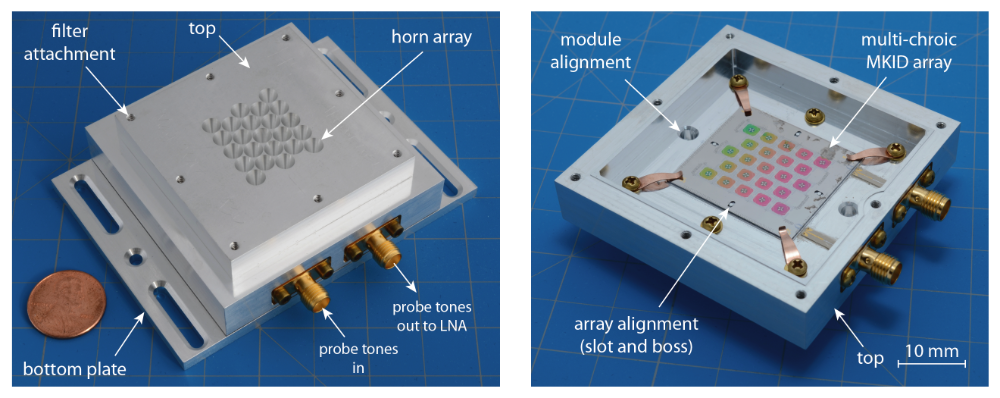Overview
Kinetic inductance detectors (KIDs) are planar superconducting resonators that can be used to detect photons. The kinetic inductance and dissipation of the superconducting film depend on the quasiparticle density. When sufficiently energetic photons are absorbed by the KID, Cooper pairs break, causing an increase in the quasiparticle density, a decrease in the resonant frequency, and a decrease in the resonator quality factor. These changes can be detected by monitoring the amplitude and phase of a probe tone that drives the resonator at its nominal resonant frequency. Each KID resonator is given a unique resonant frequency, so hundreds to thousands of detectors in an array can be read out on a single transmission line. The three KID architectures we have been developing are described below.

Multi-Chroic MKIDs

 Development of Multi-Chroic MKIDs for Next-Generation CMB Polarization Studies.” Johnson, B. R., Flanigan, D., et al. (2018) J. Low Temp. Phys., 193, 3-4, 103-112. (arXiv)
Development of Multi-Chroic MKIDs for Next-Generation CMB Polarization Studies.” Johnson, B. R., Flanigan, D., et al. (2018) J. Low Temp. Phys., 193, 3-4, 103-112. (arXiv) |
 “Kinetic inductance detectors for measuring the polarization of the cosmic microwave background.” Dr. Daniel Flanigan, Ph.D. Thesis, Columbia University, 2018.
“Kinetic inductance detectors for measuring the polarization of the cosmic microwave background.” Dr. Daniel Flanigan, Ph.D. Thesis, Columbia University, 2018. |
 “Polarization sensitive Multi-Chroic MKIDs.” Johnson, B. R., Flanigan, D., et al. (2016) Proc. SPIE, 9914, 99140X. (arXiv)
“Polarization sensitive Multi-Chroic MKIDs.” Johnson, B. R., Flanigan, D., et al. (2016) Proc. SPIE, 9914, 99140X. (arXiv) |
Dual-Polarization LEKIDs

 Design and performance of kinetic inductance detectors for cosmic microwave background polarimetry.” Dr. Heather McCarrick, Ph.D. Thesis, Columbia University, 2018.
Design and performance of kinetic inductance detectors for cosmic microwave background polarimetry.” Dr. Heather McCarrick, Ph.D. Thesis, Columbia University, 2018. |
 “Design and performance of dual-polarization lumped-element kinetic inductance detectors.” McCarrick, H., Jones, G., Johnson, B. R., et al. (2018) A&A, 610, A45. (arXiv)
“Design and performance of dual-polarization lumped-element kinetic inductance detectors.” McCarrick, H., Jones, G., Johnson, B. R., et al. (2018) A&A, 610, A45. (arXiv) |
 “Development of dual-polarization LEKIDs for CMB observations.” McCarrick, H., et al. (2016) Proc. SPIE, 9914, 99140O. (arXiv)
“Development of dual-polarization LEKIDs for CMB observations.” McCarrick, H., et al. (2016) Proc. SPIE, 9914, 99140O. (arXiv) |
Single-Polarization LEKIDs

